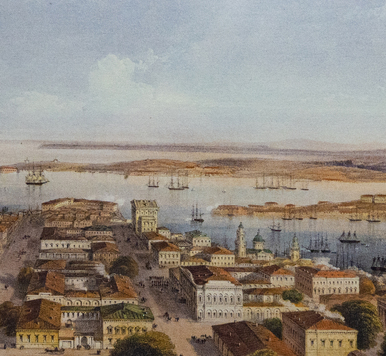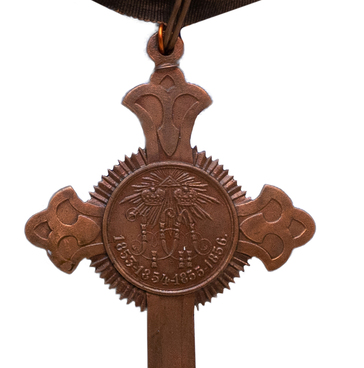The museum’s collection contains a pitcher with a scene from the Crimean War of 1853–1856 and the inscription meaning “Our army, navy and brave volunteers”. It was made of ceramics and coated on the outside with brown, green, yellow, pink and purple glazing. The inner surface has a pinkish-lilac shade.
The cone-shaped body of the pitcher is located on a low round and slightly concave stem. At the top, the neck of the product expands and ends with a triangular spout — a drain. The lower part of the body is decorated with a thickening in the form of a ring with two cylindrical projections on the sides. A curly handle is fixed to the pitcher.
The neck of the pitcher features a floral ornament in the form of acanthus leaves, an herb that is often found in the Mediterranean. The “1860” is embossed on it. Below, there is another ornament — a meander. This geometric pattern was made in the form of a broken line or spiral at a right angle.
The craftsmen placed textured images of four men in military uniforms on the body. The central medallion is framed by a laurel wreath, and inside is a female profile of young Queen Victoria. Her hair is pulled back in a bun and styled around her head. There are two crossed snakes under the Queen’s portrait.
During the Crimean War and several years after it, the Allied countries produced a lot of household and souvenir ceramics with thematic drawings. Enterprises and factories quickly responded to key military events. They created mugs and cups, snuff boxes and plates, jars and pitchers. They depicted scenes of battles, types of cities with their names, portraits of military leaders.
In the 19th century, Great Britain was the first in Europe in terms of the number of ceramic factories. The products that were made there were exported to many countries. The pitcher from the museum’s collection was created at the Sandford Pottery Workshop in Wareham, Dorset on September 28, 1860. It was a small enterprise that produced several types of pitchers. The majolica technique made the workshop famous. The ceramic products were made from colored and coarse-pored fired clay, which was then covered with glaze for strength and additional shine.
The cone-shaped body of the pitcher is located on a low round and slightly concave stem. At the top, the neck of the product expands and ends with a triangular spout — a drain. The lower part of the body is decorated with a thickening in the form of a ring with two cylindrical projections on the sides. A curly handle is fixed to the pitcher.
The neck of the pitcher features a floral ornament in the form of acanthus leaves, an herb that is often found in the Mediterranean. The “1860” is embossed on it. Below, there is another ornament — a meander. This geometric pattern was made in the form of a broken line or spiral at a right angle.
The craftsmen placed textured images of four men in military uniforms on the body. The central medallion is framed by a laurel wreath, and inside is a female profile of young Queen Victoria. Her hair is pulled back in a bun and styled around her head. There are two crossed snakes under the Queen’s portrait.
During the Crimean War and several years after it, the Allied countries produced a lot of household and souvenir ceramics with thematic drawings. Enterprises and factories quickly responded to key military events. They created mugs and cups, snuff boxes and plates, jars and pitchers. They depicted scenes of battles, types of cities with their names, portraits of military leaders.
In the 19th century, Great Britain was the first in Europe in terms of the number of ceramic factories. The products that were made there were exported to many countries. The pitcher from the museum’s collection was created at the Sandford Pottery Workshop in Wareham, Dorset on September 28, 1860. It was a small enterprise that produced several types of pitchers. The majolica technique made the workshop famous. The ceramic products were made from colored and coarse-pored fired clay, which was then covered with glaze for strength and additional shine.



